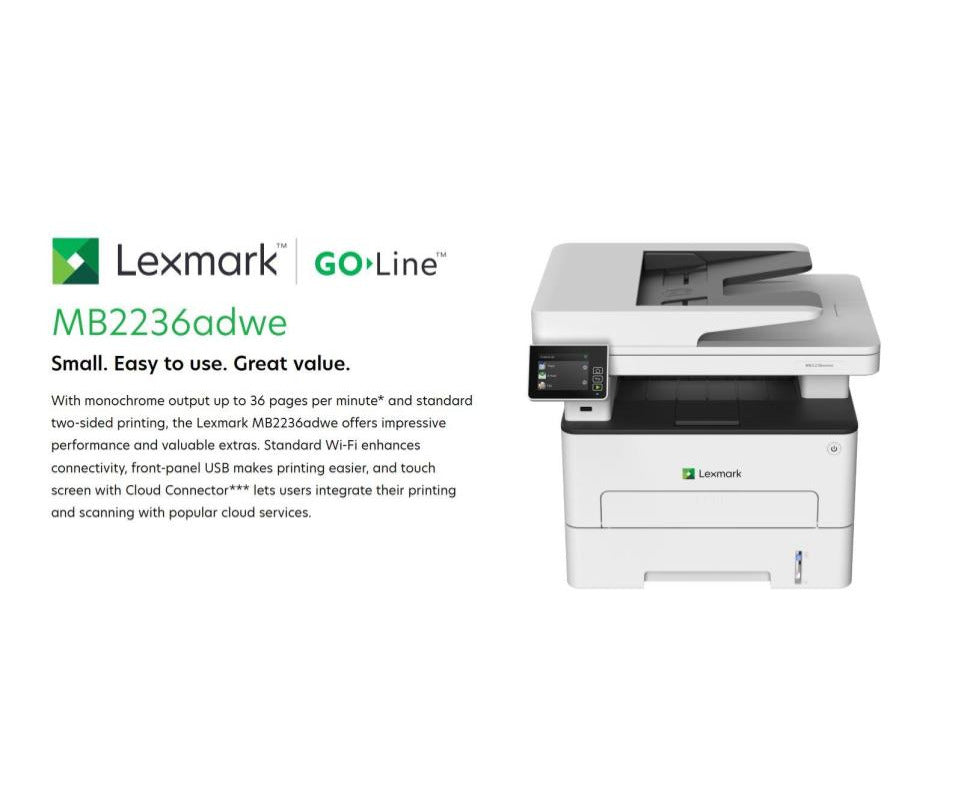The budget-priced Lexmark MB2236adw monochrome all-in-one laser printer is fast and churns out good-looking output, making it a great value for small and home-based offices.
-
PROS
- Fast.
- High volume ratings.
- Good print quality.
- Strong security features.
- Comprehensive embedded web controls.
-
CONS
- Lacks auto-duplexing ADF and NFC.
- Tedious drill-down menus on the two-line monochrome text display.
LEXMARK MB2236ADW SPECS
| Automatic Document Feeder | |
| Color or Monochrome | Monochrome |
| Connection Type | Ethernet |
| Connection Type | USB |
The Lexmark MB2236adw ($292) is an entry-level monochrome all-in-one (print, copy, scan, and fax) printer designed for use in small or home-based offices and small work groups. It prints well, and it's faster and has higher monthly volume ratings than more expensive competing models. Unlike most of its competitors, though, the MB2236adw doesn't have an auto-duplexing ADF (automatic document feeder), which can be a significant inconvenience. Despite that, the MB2236adw offers enough great perks to make it a solid option for modest-volume small offices.
A Desktop Dynamo
At 13.9 by 16.4 by 14.2 inches and weighing a mere 22 pounds, the MB2236adw is small enough to fit comfortably on most desktops and light enough to move around or relocate as needed. It's very close in size and weight to HP's entry-level LaserJet Pro M148fdw, more than 8 pounds lighter than the Editors' Choice Canon imageClass MF249dw, and similar in size but 5.7 pounds lighter in heft than Brother's MFC-L2750DW XL. The MB2236adw is, on the other hand, significantly smaller and about half as heavy as (and lists for about $100 less than) Epson's WorkForce Pro WF-M5799, a monochrome AIO inkjet laser alternative.
The MB2236adw comes with a 50-sheet manual-duplexing automatic document feeder, compared with the auto-duplexing ADFs on both the MF249dw and the MFC-L2750DW XL. These, of course, allow you to scan two-sided multipage documents without having to turn the originals over manually to capture the other side. The HP M148fdw's ADF holds only 35 sheets, though, and it, too, doesn't support auto-duplexing.

You can set up walk-up tasks, such as making copies or scanning to the cloud, from the MB2236adw's sparse, vintage-looking control panel. That panel, shown in the image below, consists of a handful of buttons, including two navigation arrow keys for scrolling through a somewhat confusing set of drill-down menus on a two-line monochrome text display, and a number pad.

However, nearly everything you can do from the control panel is also accessible from a much more logically arranged and easier-to-use website embedded in the MB2236adw's firmware, shown below. From here, you can make copies, scan documents to the cloud, send faxes, and so on, as well as configure all aspects of the device itself. The embedded web server is also accessible from mobile devices.

The MB2236adw, like the MF249dw and MFC-L2750DW XL, has a paper capacity of 251 sheets, split between a 250-sheet main cassette and a one-sheet override tray (for printing one-off envelopes, labels, and so on). The M148fdw holds up to 260 sheets split between two input sources, and the WF-M5799 holds up to 330 sheets expandable to 830 from three separate input sources.
The MB2236adw's maximum monthly duty cycle is 30,000 pages, with a 2,500-page recommended monthly print volume, which is about midrange among the machines discussed here so far.
Above-Average Security
Standard interfaces on the MB2236adw include Ethernet, Wi-Fi, and connecting to a single PC via USB, but you don't get a USB port for printing from and scanning to flash memory devices. Mobile connectivity comprises Apple AirPrint, Mopria, and Android and iOS versions of the Lexmark Mobile Print app.

The MB2236adw comes with an impressive range of drivers for several operating systems and protocols, including numerous versions of Windows and Windows Server, macOS through AirPrint and AirScan, several flavors of Linux, many iterations of Citrix MetaFrame, and a wide array of Novell operating systems.
Security, too, is robust for an under-$300 AIO. You can protect sensitive documents with PINs, as well as restrict or deny access to features or the printer itself at either user or group levels. Other restrictions can be as finite as you need. You can, for example, have the AIO email you when specific events, such as failed login attempts, invalid PIN entries, or attempted schedule breaches, occur. The MB2236adw can also lock out users after a predefined number of failed logins, and then, after a specified period, have the printer unlock the account again. In other words, if you (or your IT manager) are willing to take the time to configure it, the MB2236adw provides an intricate automated security system.

Above Entry-Level Speeds
Like most other Lexmark printers, the MB2236adw comes out of the box with the driver set to print two-sided pages automatically. In this scenario, we time and record not only the one-sided (simplex) print speeds, but also their two-sided, or auto-duplexing, scores. Lexmark rates the MB2236adw at 36 pages per minute (ppm) in simplex mode and 18 images per minute (or ipm, where each page side is considered an image) in duplex mode.
From our Intel Core i5 testbed PC, over Ethernet, running Windows 10 Professional, it printed our 12-page Microsoft Word monochrome text document on one-sided pages at the rate of 36.7ppm and two-sided pages at 18.8ipm, slightly besting Lexmark's rating in both modes and beating all of the competitors mentioned here.
For the next part of my tests, I timed the MB2236adw as it printed a collection of complex Adobe Acrobat and Microsoft Excel and PowerPoint business documents imbued with elaborate charts, graphs, and other types of business graphics. Then, I combined the scores of these print runs with the results from printing the 12-page text file, to come up with a comprehensive score for churning out our entire suite of test documents.
The MB2236adw printed the entire set of documents at a rate of 19.5ppm. Here, again, the MB2236adw pulled ahead of the other monochrome AIOs discussed here.
Excellent Monochrome Output
I have no complaints about the MB2236adw's print quality. Its well-shaped and highly legible text is suitable for most business settings, except, perhaps, those that require tiny type. The full-page business graphics and PowerPoint handouts in our suite of test documents came out set in attractive grayscale with no notable flaws (only barely perceptible banding and no streaking), and the embedded grayscale photos were better than newspaper quality.
Expectedly High Running Costs
When you buy the highest-yield 6,000-page "return" toner cartridge for this printer, the first 12,000 pages will cost you about 2.7 cents each. Then, after those and every other 12,000 pages, you must replace the imaging drum, and that bumps the per-page price up to 3.4 cents. (The "return" program means you must recycle the empties through Lexmark.) While these running costs are high compared with more expensive competitors, they are on par with other entry-level models, which typically are expensive to use.
A Low-Volume Bargain
We have few complaints about the Lexmark MB2236adw, but the one we do have—its lack of an auto-duplexing ADF—is significant. The ability to scan and copy two-sided multipage documents unattended is a standard staple even among entry-level AIOs. If that feature is important to your office, we suggest checking out the Editors' Choice Canon MF249dw. (Just note that choosing that model will mean sacrificing a bit on duty cycle.) Otherwise, the MB2236adw is a highly capable AIO. It prints fast and well, and has strong security features. If you don't foresee scanning or copying many two-sided multipage documents in your office's future, it's well-suited for churning out low-volume prints and copies in small and home-based offices or work groups.




